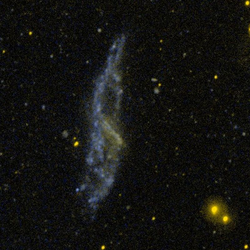A bizarre cosmic rarity NGC 660
NGC 660 is classified as a "polar ring galaxy", meaning that it has a belt of gas and stars around its centre that it ripped from a near neighbour during a clash about one billion years ago. The first polar ring galaxy was observed in 1978 and only around a dozen more have been discovered since then, making them something of a cosmic rarity.
Unfortunately, NGC 660’s polar ring cannot be seen in this image, but has plenty of other features that make it of interest to astronomers – its central bulge is strangely off-kilter and, perhaps more intriguingly, it is thought to harbour exceptionally large amounts of dark matter. In addition, in late 2012 astronomers observed a massive outburst emanating from NGC 660 that was around ten times as bright as a supernova explosion. This burst was thought to be caused by a massive jet shooting out of the supermassive black hole at the centre of the galaxy.Relevante Bilder
Relevante Artikel
NGC 660NGC 660 ist eine aktive Balken-Spiralgalaxie mit hoher Sternentstehungsrate im Sternbild Fische auf der Ekliptik, die etwa 42 Millionen Lichtjahre von der Milchstraße entfernt ist. NGC 660 ist eine der wenigen Polarring-Galaxien. .. weiterlesen
FormaldehydFormaldehyd (IPA: [ˈfɔɐ̯m.aldehyːt],, auch [fɔʁm.aldeˈhyːt], ; systematischer Name Methanal) ist eine organisch-chemische Verbindung mit der Summenformel CH2O und der einfachste Vertreter aus der Stoffgruppe der Aldehyde. Unter Standardbedingungen ist Formaldehyd ein Gas mit einem stechenden Geruch. .. weiterlesen





























